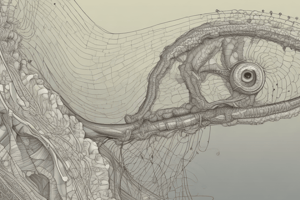Podcast
Questions and Answers
What is a characteristic of asexual reproduction?
What is a characteristic of asexual reproduction?
- It always leads to a change in the number of chromosomes
- It does not involve the fusion of gametes (correct)
- It always results in genetically diverse offspring
- It involves the fusion of gametes
Which organisms primarily reproduce asexually?
Which organisms primarily reproduce asexually?
- Eukaryotes and prokaryotes
- Archaea and bacteria (correct)
- Fungi and vertebrates
- Plants and animals
What mechanism for lateral gene transfer can be likened to sexual reproduction in prokaryotes?
What mechanism for lateral gene transfer can be likened to sexual reproduction in prokaryotes?
- Transformation
- Conjugation (correct)
- Budding
- Binary fission
What is the most common form of asexual reproduction in vertebrates?
What is the most common form of asexual reproduction in vertebrates?
What is the result of asexual reproduction in terms of genetic similarity?
What is the result of asexual reproduction in terms of genetic similarity?
Hydra is example of
Hydra is example of
Flashcards are hidden until you start studying
Study Notes
Asexual Reproduction
- A characteristic of asexual reproduction is that it produces offspring that are genetically identical to the parent.
- Organisms that primarily reproduce asexually include bacteria, archaea, and some single-celled eukaryotes.
Lateral Gene Transfer
- Conjugation is a mechanism for lateral gene transfer that can be likened to sexual reproduction in prokaryotes.
Asexual Reproduction in Vertebrates
- The most common form of asexual reproduction in vertebrates is parthenogenesis, which occurs in some species of fish, reptiles, and amphibians.
Genetic Similarity
- The result of asexual reproduction is offspring that are genetically identical to the parent, resulting in no genetic variation.
Hydra
- Hydra is an example of an organism that can reproduce asexually through a process called budding.
Studying That Suits You
Use AI to generate personalized quizzes and flashcards to suit your learning preferences.




